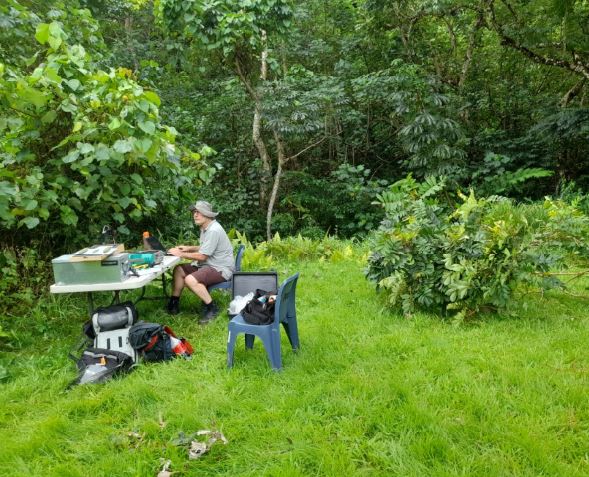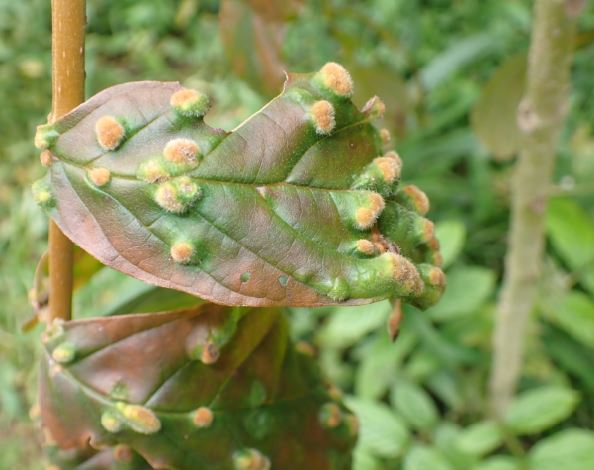Drones show African tulip trees’ ‘small but mighty’ natural enemies are doing their job
Saturday 2 September 2023 | Written by Losirene Lacanivalu | Published in Environment, National

Manaaki Whenua- Landcare Research (MWLR) team was assisted by the National Environment Service, the Ministry of Agriculture, and members of the Te Ipukarea Society and the Natural Heritage Trust. SUPPLIED / 23082807 / 23082808 / 23082809 / 23082813
Aerial images collected during a survey on Rarotonga’s forests earlier this month show that the beetles released in 2021 to control the African tulip trees have been successful.
According to Manaaki Whenua- Landcare Research (MWLR), senior communications advisor Kim Triegaardt, the beetles were first released in 2021 with several more releases last year.
Researchers were excited to see that the aerial images did show tell-tale evidence of successful establishment.
Researchers, drones and a plane were on the ground and in the air in July and August to survey forests in Rarotonga for any damage caused by the trees’ natural enemies, the gall-forming mite (Colomerus spathodeae) and leaf-mining flea-beetle (Paradibolia coerulea).
The teams sampled at various release sites across the island including in the Avatiu Valley and the Takitumu Conservation Area (TCA) among others, to look for signs the beetle has established.
Triegaardt said these natural enemies were released in the Cook Islands to tackle this invasive weed after rigorous testing by MWLR researchers and colleagues at Rhodes University in South Africa confirmed both the mite and the beetle are African tulip tree specialists.

Manaaki Whenua- Landcare Research (MWLR) team was assisted by the National Environment Service, the Ministry of Agriculture, and members of the Te Ipukarea Society and the Natural Heritage Trust. SUPPLIED / 23082807 / 23082808 / 23082809 / 23082813
This means they only eat and survive on the African tulip tree, so they pose no risk to other plant species in the Pacific region.
Researchers used a plane and drones, because while the gall mite is already well established and damage is easy to spot, it’s much harder to see from the ground how the beetles are doing at this early stage while their numbers are still low.
During the aerial survey, drones were flown by specialists from New Zealand research organisation MWLR - using their aerial point of view to provide close-up images of the African tulip tree canopy.
The data they gathered showed the current extent of the African tulip tree on Rarotonga so that changes in the distribution and abundance of this tree can be tracked over time.
By using a drone, an aeroplane, and satellite, researchers were able to compare different approaches to decide on the most efficient way of mapping the spread of African tulip trees.
The use of natural enemies to manage such a large target is expected to be a slow process likely taking decades, and aerial photography is likely to be the best way to monitor progress.
The African tulip tree (Spathodea campanulata) is a destructive alien invasive tree that is widespread throughout the Pacific Region and considered one of the 100 worst alien invasive species in the world.
Originally from West Africa, it was introduced into the Cook Islands as an ornamental plant but has now naturalised and become a threat to indigenous biodiversity and agriculture in other Pacific Islands.

Gall mite (Colomerus spathodeae) symptoms – each gall (technically an erineum) can contain hundreds of mites that crawl out and either move to a fresh area on the same plant or disperse over longer distances in the wind. 23082810 / 23082812
The African tulip tree invades indigenous forests and arable land causing reductions in natural biodiversity and agricultural productivity.
To make matters worse, invasive species like this make ecosystems and communities more vulnerable to natural disasters and the impacts of climate change. Because weeds like African tulip trees thrive on disturbance, they are often the first species to recover after storms and cyclones, taking up residence in previously uninvaded areas.
The density and distribution of African tulip trees in the Cook Islands would likely increase if control measures are not implemented.
The work to tackle the African tulip tree problem in the Pacific, through the use of natural enemies, has been mostly funded by New Zealand’s Ministry of Foreign Affairs and Trade, with the project in the Cook Islands assisted by the National Environment Service, the Ministry of Agriculture, and members of the Te Ipukarea Society and the Natural Heritage Trust.









































